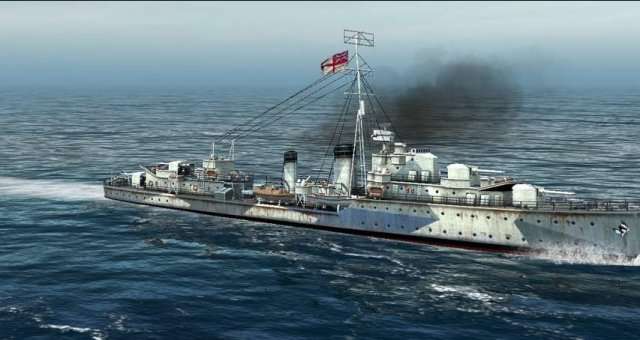
The torpedo range information in the game manual is incorrect. For years I have worked with rough correct values in my head, but every time I put the game down for a while I forget them. So I’m documenting some reasonably exact values.
Principles and Assumptions
All credit goes to The Inept European!
So far it looks like the speeds in knots, and maximum range in yards, as quoted in Manual section 5.2.2, are correct. It’s only the “yards per turn” numbers that are wildly wrong, and inconsistent with each other.
I’m working my way through to verify the correct yards/turn values, but so far it’s panning out. That means you can work these values out for yourself, provided you are aware of some basic assumptions:
- The smallest distance unit in the game is 100m, the size of one grid edge at 128x map magnification
- That’s 100m not 100yds, so to compare with the fuzzy range estimates from your crew you need to add about 9%
- The time unit of the game is a 1 minute turn
- Movement speeds are multiplied 4x, meaning a 30kts ship is moving 120kts and a 35kts torp is moving 140kts
- Object sizes (ships) are 4x bigger, meaning a grid edge at 128x scale is only 25m (not 100m) for the purposes of depicting the size of ships
- When a torpedo is fired it immediately moves one half a turn’s movement Then after the target’s movement (after all other movement), the torpedo moves the other half of its movement for that turn
- In subsequent turns the torpedo only moves a full move, at the end of the turn, after all ships have moved
Knowing all that, you can calculate what I am calculating.
Data
Here are some key data. I will give all these distances in “game units” (u) which are 100m, or also one grid square at 128x map scale.
RN submarine torpedo
1st half move: 25.3u
2nd half move: 50.6u
2nd full move: 64u (max range)
Max range: 64u
RN surface torpedo
1st half move: 21.6u
2nd half move: 43.2u
2nd full move: 86.4u
Max range: 128u
KM sub/surface torpedo
1st half move: 18.5u
2nd half move: 37u
2nd full move: 74u
Max range: 137u
Analysis and Tactical Implications
What does this tell us, tactically? A few things:
Speed is more important than range. A slow, long range torpedo can be dodged, or evaded by a convoy zig zag pattern. A fast, short range torpedo is harder to dodge.
Speed, not range, gives the stand-off advantage in “knife fights” between torpedo users.
The RN have the better weapons for fighting (if not necessarily for sinking merchants).
The RN sub has a 6.8u (680m/730yd) stand-off advantage in the “instakill” range band and a 13.6u (1360m/1460yd) stand-off advantage in the “hit after one move” range band.
The RN escort has a 3.1u (310m/330yd) stand-off advantage in the “instakill” range band and a 6.2u (620m/660yd) stand-off advantage in the “hit after one move” range band.
Both of these RN stand-off advantages apply equally against KM subs and against KM escorts.
Of course, any use of torpedoes for ASW work is an a-historical cheat, and even using sub torps against destroyers, or destroyer torps against destroyers, is a stretch since these torps are OP.
Why are torps OP? It’s not so much that the torp speeds are quadrupled, because the ship speeds are also quadrupled. The torps are OP because the target is forced to move on its predicted course for the equivalent of 2 or 4 minutes while the torpedo makes its run. The ships being 4x bigger targets than normal is also a big factor (outside of point blank range anyway).


Be the first to comment